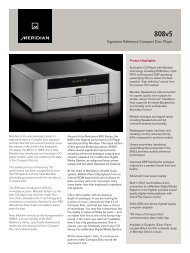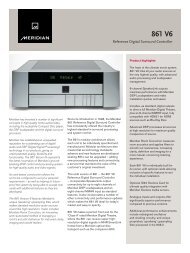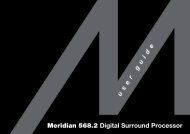G61R Digital Surround Controller Installation Guide - Meridian
G61R Digital Surround Controller Installation Guide - Meridian
G61R Digital Surround Controller Installation Guide - Meridian
You also want an ePaper? Increase the reach of your titles
YUMPU automatically turns print PDFs into web optimized ePapers that Google loves.
DSP presets for two-channel material<br />
The <strong>G61R</strong> provides several signal processing options for two-<br />
channel material. The Music DSP presets are designed for use with<br />
music from sources such as CD or radio:<br />
• Music, Trifield, Ambisonics, Super Stereo, Music Logic, PLIIx Music,<br />
Stereo, and Direct.<br />
The Logic DSP presets are designed for use with film soundtracks<br />
or TV programmes:<br />
• PLIIx Movie, PLIIx THX, TV Logic, and Mono.<br />
The Music and Logic DSP presets use the Music and Logic speaker<br />
layout respectively; see Speaker layouts, page 35.<br />
Music<br />
The Music DSP preset extracts the mono and surround components<br />
of the original recording. These components provide an alternative<br />
representation of the original sound, and this is sometimes used<br />
for recording systems or in broadcasts such as FM radio. The mono<br />
element is equalised using a proprietary <strong>Meridian</strong> technique to<br />
match the tone colour of the centre speaker, and to compensate<br />
Music and Trifield DSP preset parameters<br />
for the fact that the frequency response of human hearing changes<br />
with direction.<br />
The Music DSP preset is recommended for recordings made with<br />
spaced omnidirectional microphones, or using a mono-surround<br />
technique.<br />
Trifield<br />
As for the Music DSP preset, the Trifield preset extracts the mono<br />
and surround components of the original recording. It then<br />
calculates the signals for the front, left, centre, and right speakers,<br />
using the phase and amplitude differences between the three front<br />
channels, to redistribute the sounds on a frequency-dependent basis.<br />
This gives a significant improvement over traditional stereo, which<br />
converts the differences between the microphone signals into<br />
amplitude differences in the speaker signals. This version of the<br />
Trifield algorithm is virtually impossible to implement without<br />
digital signal processing.<br />
Parameter Options What it changes<br />
Trifield is recommended for well-made recordings and stereo<br />
television broadcasts that are not Dolby <strong>Surround</strong> encoded. An<br />
advantage over the Music DSP preset is that the front stereo image<br />
is more focused, and the width of the image can be adjusted.<br />
Centre Flat, EQ1-3 The timbre of the centre loudspeaker.<br />
Width† 0-1.5 The width of the image.<br />
Surr. Rear Surr. Rear, Surr. Side, Surr. All Switches the surround signal between the side and rear speakers.<br />
R Filter Off, 1kHz, 3kHz, 7kHz The cutoff of high frequencies from the rear surrounds.<br />
S Filter Off, 1kHz, 3kHz, 7kHz The cutoff of high frequencies from the side surrounds.<br />
†Trifield only.<br />
D S P p r e s e t s






